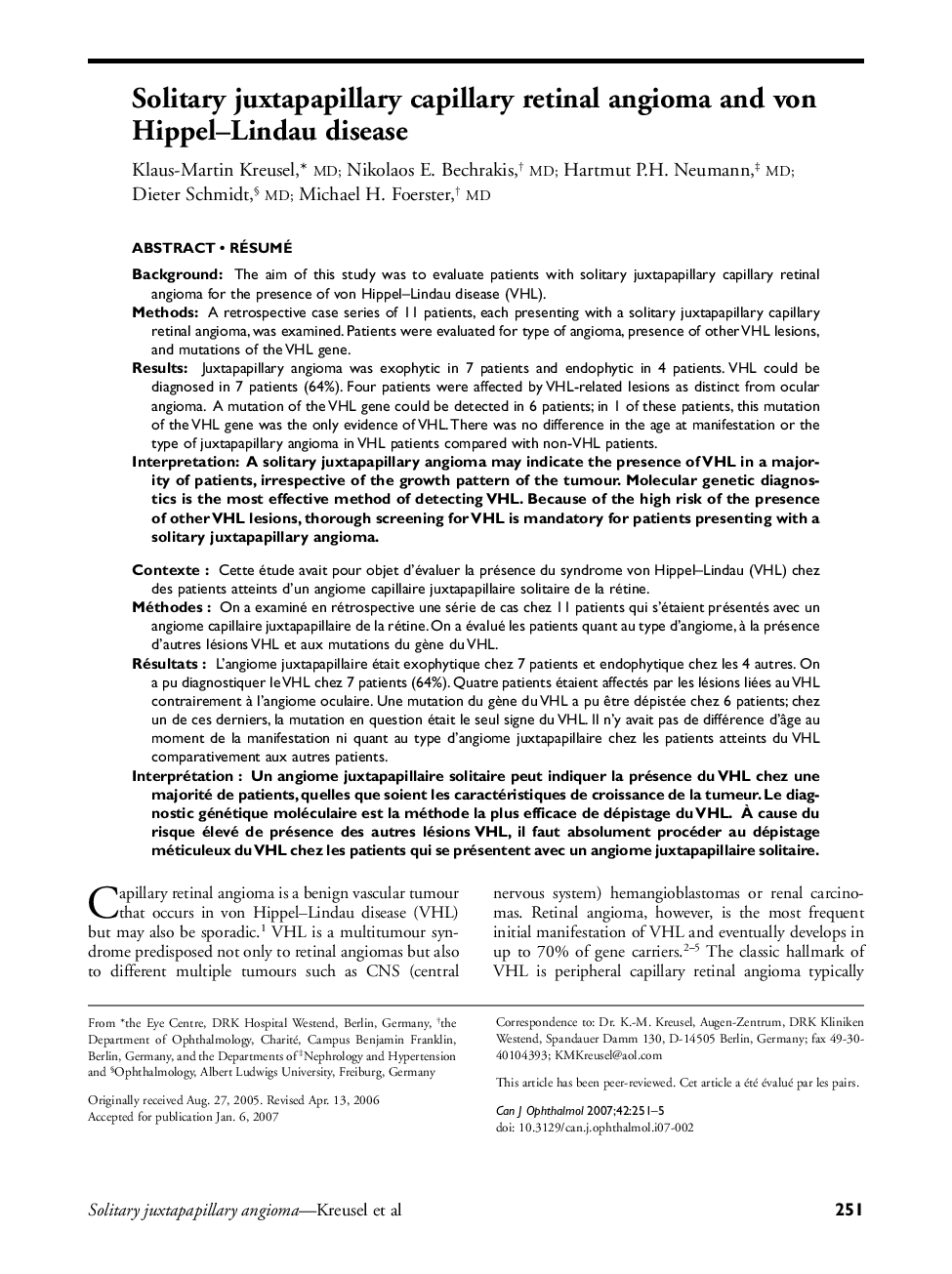| Article ID | Journal | Published Year | Pages | File Type |
|---|---|---|---|---|
| 4010754 | Canadian Journal of Ophthalmology / Journal Canadien d'Ophtalmologie | 2007 | 5 Pages |
Background: The aim of this study was to evaluate patients with solitary juxtapapillary capillary retinal angioma for the presence of von Hippel—Lindau disease (VHL).Methods: A retrospective case series of 11 patients, each presenting with a solitary juxtapapillary capillary retinal angioma, was examined. Patients were evaluated for type of angioma, presence of other VHL lesions, and mutations of the VHL gene.Results: Juxtapapillary angioma was exophytic in 7 patients and endophytic in 4 patients. VHL could be diagnosed in 7 patients (64%). Four patients were affected by VHL-related lesions as distinct from ocular angioma. A mutation of the VHL gene could be detected in 6 patients; in 1 of these patients, this mutation of the VHL gene was the only evidence of VHL.There was no difference in the age at manifestation or the type of juxtapapillary angioma in VHL patients compared with non-VHL patients.Interpretation: A solitary juxtapapillary angioma may indicate the presence ofVHL in a majority of patients, irrespective of the growth pattern of the tumour. Molecular genetic diagnostics is the most effective method of detecting VHL. Because of the high risk of the presence of other VHL lesions,thorough screening for VHL is mandatory for patients presenting with a solitary juxtapapillary angioma.
RésuméContexte: Cette étude avait pour objet d’évaluer la présence du syndrome von Hippel—Lindau (VHL) chez des patients atteints d’un angiome capillaire juxtapapillaire solitaire de la rétine.Méthodes: On a examiné en rétrospective une série de cas chez 11 patients qui s’étaient présentés avec un angiome capillaire juxtapapillaire de la rétine. On a évalué les patients quant au type d’angiome, à la présence d’autres lésions VHL et aux mutations du gène du VHL.Résultats: L’angiome juxtapapillaire était exophytique chez 7 patients et endophytique chez les 4 autres. On a pu diagnostiquer le VHL chez 7 patients (64%). Quatre patients étaient affectés par les lésions liées au VHL contrairement à l’angiome oculaire. Une mutation du gène du VHL a pu être dépistée chez 6 patients; chez un de ces derniers, la mutation en question était le seul signe du VHL. Il n’y avait pas de différence d’âge au moment de la manifestation ni quant au type d’angiome juxtapapillaire chez les patients atteints du VHL comparativement aux autres patients.Interprétation: Un angiome juxtapapillaire solitaire peut indiquer la présence du VHL chez une majorité de patients, quelles que soient les caractéristiques de croissance de la tumeur. Le diagnostic génétique moléculaire est la méthode la plus efficace de dépistage du VHL. À cause du risque élevé de présence des autres lésions VHL, il faut absolument procéder au dépistage méticuleux du VHL chez les patients qui se présentent avec un angiome juxtapapillaire solitaire.
